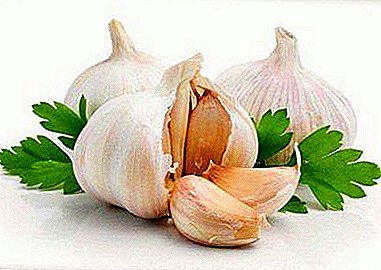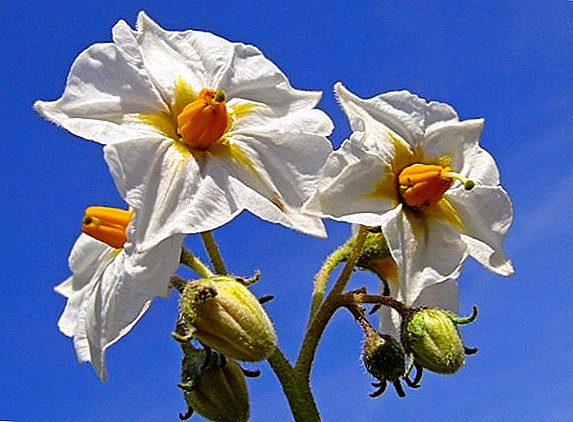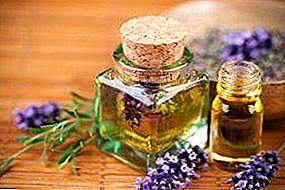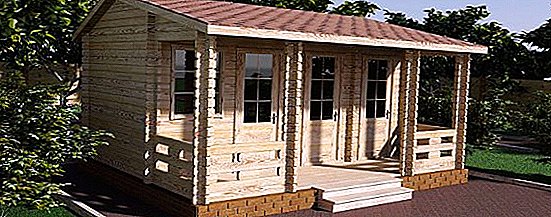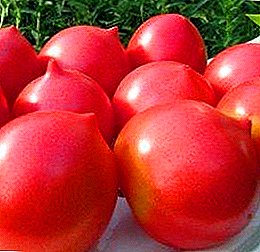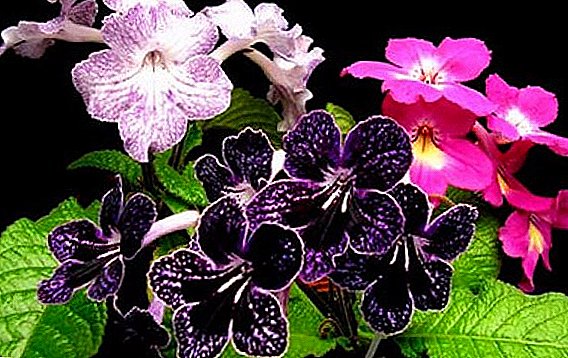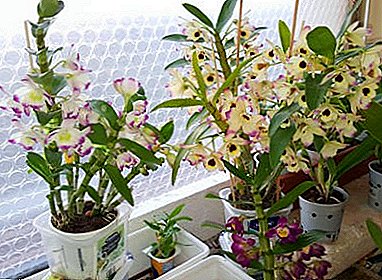
Dendrobium is not a capricious plant. Caring for this plant is not difficult. Therefore, it is worth boldly to go to the store for this plant. It enchants with its appearance and delicate aroma.
In our article we will look at the features of this orchid in detail and talk about the rules for the care of this delicate, exotic flower. You can also watch a useful video on this topic.
Features of the form
Dendrobium orchid is a small plant. Peduncles consist of beautiful unusual flowers. One peduncle may consist of 1-4 flowers with a diameter of 6-8 cm. Shades of flowers can be different, white, lilac, orange, yellow, and sometimes two and tricolor. Flowers completely cover the stem of the plant, which has a cylindrical shape. The stem grows in height from 40 to 90 cm. It alternately leaves are located. The shape of the leaves is lanceolate.
The peculiarity of this type of orchid is that the dendrobium grows on trees, earth, rocks. The name Dendrobium in translation means "living on a tree."
A photo





How to care?
A distinctive feature of the dendrobium is that it has a period of rest. After it fades, it seems that it ceases to grow, it is not so, in fact, it begins a period of rest. In this case, watering is reduced to a minimum. The temperature is also better to maintain quite low around 17-21 degrees. After the end of dormancy, the plant begins to grow new shoots.
Dendrobium blooms in solid bushes, when you can not see any pseudobulb or leaves. It may seem that these are just balls of flowers. An interesting feature of this plant is the presence of his so-called children. If the dendrorium does not bloom in time and the children grow up on a pseudobulb, this is a sign that the care is not correct.
Sometimes the dendrobium can take root above the groundIn this case, you do not need to do anything. If you sprinkle earth on top, the plant may stop growing.
What conditions are necessary for the plant?
Due to the fact that the dendrobium is considered to be a member of the epiphytic family, it is worthwhile to understand that good care at home is to provide moist air, sufficient lighting and the optimum amount of moisture.
Tips for choosing
Pot
Orchid pot should choose a ceramic or plastic, preferably not transparent. This plant needs drainage. Therefore, it is imperative to place a drainage layer on the bottom of the pot.
What soil is needed?
 What land is needed for a plant? Gardeners are advised to use special soil for dendrobium intended for epiphytic orchids. A good option for growing orchids is to prepare the earth mixture yourself. It is required to mix peat soil, sphagnum, pine bark and charcoal. Peat is needed to provide the recommended acidic environment.
What land is needed for a plant? Gardeners are advised to use special soil for dendrobium intended for epiphytic orchids. A good option for growing orchids is to prepare the earth mixture yourself. It is required to mix peat soil, sphagnum, pine bark and charcoal. Peat is needed to provide the recommended acidic environment.
When preparing the soil yourself, it is advisable to boil the future substrate for 10 minutesand then dry. It is worth doing in order to disinfect the soil, so it is possible to avoid plant infection by pests and bacteria.
At the bottom of the pot stack drainage, consisting of rubble or broken brick. Gardeners recommend laying large pieces of tree bark over the drainage. Then put the crushed pieces of bark.
We recommend to watch the video on the preparation of the substrate for dendrobium:
Location
Dendrobium needs sunbathingTherefore, to ensure favorable conditions for the existence of a flower, it is required to put it on the windows facing the south side. When placing the plant on the east or west side, it will be necessary to install additional artificial lighting. The windows on the north side are not at all suitable for providing comfortable conditions to the dendrobium.
Lighting
Dendrobium is a light-loving plant. It is necessary to provide him a bright light, but not direct sunlight.
Important: Immediately the plant can not be put on bright sunlight, it must be slowly trained. If the plant is located in direct sunlight, it is necessary to ensure the movement of air.
How often to water and arrange a shower?
During the growing season, the plant needs a lot of water.. Watering is recommended, without waiting for the substrate to dry out. If it is a hot day, watering should be done every day. If the weather is cloudy, rainy, you need to water when the substrate begins to dry, about 2 times a week. If water remains in the pan, it must be drained 15 minutes after watering. This time is enough for the flower to be saturated with water. Otherwise, the roots can simply rot.
 The best time for watering is morning. With the onset of frost is to stop watering the flower. At the same time, it is required to wash the potted roots with clean running water in order to wash off all the remaining salt and extra fertilizer. Roots must remain clean for a rest period. Watering stops until the flower buds wake up.
The best time for watering is morning. With the onset of frost is to stop watering the flower. At the same time, it is required to wash the potted roots with clean running water in order to wash off all the remaining salt and extra fertilizer. Roots must remain clean for a rest period. Watering stops until the flower buds wake up.
Dendrobium prefers to be in a room with high humidity. To provide the orchid with favorable conditions, it is recommended to spray it every day.
Watering should be carried out with water at room temperature, it is desirable that it be settled.
We recommend to watch the video about the proper watering of the Dendrobium orchid:
Temperature
Dendrobium - a plant resistant to any temperature. It can even withstand negative temperatures. In the heat it can be in conditions with temperatures up to 38 degrees. Of course, do not forget about the ventilation of the air.
Orchid is extremely bad for large and sharp fluctuations in temperature, as well as cold!
Fertilizer
Feed denrobium is necessary, since spring. It is recommended to use complex fertilizer, where nitrogen, phosphorus, and potassium are contained in equal proportions. Fertilizer frequency - once a week. To get a gorgeous flowering, fertilizer solution should be in the ratio: 1 teaspoon per 4 liter bucket.
It is necessary to spill fertilizer after watering the plant, then the roots are already saturated with moisture, which will allow them not to burn. Starting in August, the fertilizer should be of a different type. From now on there should be no nitrogen in the fertilizers. Otherwise, kids will grow up on pseudobulbs. Thus, you can get lush flowering at the end of winter.
Courtship errors
- If the dendrobium does not receive a sufficiently dry and cool period, the children will not grow from the substrate, not from the roots, but on the plants themselves.
- Spraying this plant, it is necessary to exclude the ingress of water into the sinuses of the leaves. If the water gets into the leaf bosoms, the trunk will begin to rot. It is advisable to place the pot with the plant in a container with wet peat, expanded clay or moss.
- Improper care can affect the health of the flower. At observance of all requirements for ensuring comfortable conditions, leaves of a plant will have a green color without changes in any direction:
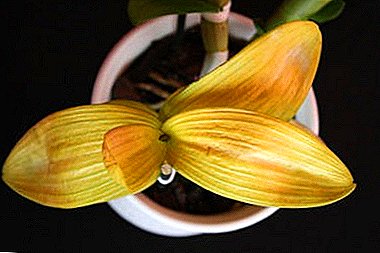 When painting leaves in bright green color, it is necessary to provide the plant with a small shade, since too much sun gets on the flower.
When painting leaves in bright green color, it is necessary to provide the plant with a small shade, since too much sun gets on the flower.- If the leaves of the dendrobium are dark green in color, this means that there is not enough light for the flower.
- When coloring leaves in yellow color, it is necessary to change the place of stay of the plant, as this suggests that the flower is not enough sun.
- With increased humidity, the dendrobium can become infected with a fungus. This suggests that the soil is excessively poured, which leads to rotting of the roots. This is a difficult case, because it is very difficult to help such a plant; it can only be reanimated by transplanting it into a new soil. A prerequisite is the removal of all rotten roots and their parts. Uninfected roots must be treated with charcoal and dried. After this procedure, watering the plant should begin only ten days from the date of transplantation.
- If the dendrobium does not bloom for a long time, it can be assumed that the reason for this may be excessive illumination during the resting period of the flower, or watering during the formation of buds, so the flowers do not appear, but new children form. Also, the reason for this is the lack of illumination during the growth of the flower.
- Another problem is the coloring of the pseudobulb in brown or yellow. The reason for this may be the beginning of the process of decay of the plant as a result of improper watering. The solution is to remove damaged parts or transplant dendrobium.
Board: It is worth carrying out a transplanting of a flower only after preliminary cleaning of a plant of the decayed roots. Yellow is always a sign of illness.
- Lower leaves may fall off. In this case, do not worry, because it is a normal phenomenon after a period of flowering in the plant.
- Sometimes you will notice that the plant has a wrinkled stem. This happens during the growth of new shoots. Young shoots need a large amount of nutrients, which they safely take away from the plant itself, which leads to its slight drying. Shoots may look excessively thin, and new shoots gradually gain the required thickness. After the end of growth, they will have a standard look.
Conclusion
Dendrobium orchid - a bright flower that requires individual care and careful handling. The plant is incredibly beautiful, and under all conditions for creating a comfortable environment, the dendrobium will delight all households for many years.


 When painting leaves in bright green color, it is necessary to provide the plant with a small shade, since too much sun gets on the flower.
When painting leaves in bright green color, it is necessary to provide the plant with a small shade, since too much sun gets on the flower.
